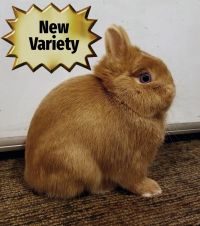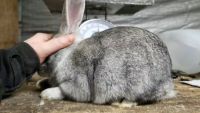Difference between revisions of "Advanced Color Genetics"
(→Vienna) |
|||
| (24 intermediate revisions by 6 users not shown) | |||
| Line 1: | Line 1: | ||
=More Advanced Color Genetics | = More Advanced Color Genetics = | ||
== Broken Locus == | |||
* '''En – Broken''' [[File:Geneiticx3_Brokens.jpg|thumb|Broken]] | |||
The Broken pattern is dominant over solid. Rabbits homozygous for the Broken gene are called '''Charlies''' and should only be carefully bred. Homozygous Broken carries a ~70% probability of producing rabbits with megacolon, a digestive disorder. | |||
* | == Vienna == | ||
* '''V – Vienna''' [[File:Geneiticx3_Vienna.jpg|thumb|Vienna]] | |||
Vienna is a co-dominant gene. Two copies (vv) produce '''Blue-Eyed White (BEW)''' rabbits. Rabbits with one copy (Vv) are carriers, sometimes showing random white markings and blue eye coloration in one, part, or both eyes. BEW is only expressed in homozygous recessive rabbits (vv). | |||
== | == Wideband == | ||
* | * '''W – Wideband''' | ||
Wideband is a trait modifier affecting Agouti-based rabbits. It extends the band coverage, especially in Chestnut, Red, and Chinchilla rabbits: | |||
* Chestnut → larger area of pheomelanin, less white, more red/yellow on the belly | |||
* | * Chinchilla → more white on the coat and belly | ||
* Red → solid red belly extending from back | |||
Wideband high-rufus Reds and Chestnuts are desirable in New Zealand Red programs. | |||
* Normal bandwidth: dominant "W" | |||
* | * Wideband: homozygous recessive "ww" | ||
== | == Dutch == | ||
* | * '''Du''' – regular color | ||
* '''dud''' – Dutch dark | |||
* '''duw''' – Dutch white | |||
[Reference PDF](https://www.adhrc.com/Forms/Color%20Genetics%20of%20the%20Dwarf%20Hotot.pdf) | |||
== Silver == | |||
* '''Si – Silver''' | |||
The Silver gene produces hairs that are fully white from root to tip, evenly intermixed with body-color hairs. | |||
[[File: | == Lutino == | ||
[[File:Lutino.jpg|200px|thumb|left|Lutino Rabbit]] | |||
The Lutino coloration is a '''p mutation''' affecting an integral membrane protein involved in pigmentation. This mutation reduces eumelanin production in both the eyes and coat, creating pink eyes and lighter coat colors. | |||
* Recessive: P = normal, p = mutation. Homozygous pp expresses pink eyes and coat color change. | |||
* | * Genotypes: | ||
* | * Basic orange Lutino: A_B_C_D_eepp | ||
* | * Cream Lutino (“Shadow”): A_B_C_D_E_pp | ||
The Lutino gene functions similarly to the non-extension gene but with pink eyes and less effect on pheomelanin. It has been studied extensively in mice (Castle 1909) and rabbits (SoftPawsRabbits, 1985–2014). | |||
References: | |||
1. Rosemblat et al., 1994, PNAS 91:12071–12075 | |||
2. Russell, Genetics 34:146, 1949 | |||
3. Castle, Science 30(766):313–314, 1909 | |||
[SoftPawsRabbits Lutino Gene](https://softpawsrabbits.weebly.com/the-lutino-gene.html) | |||
== Modifiers == | |||
Modifiers are not genes themselves but affect the extent of coverage or intensity of rabbit coat colors. | |||
=== Intensity of Red === | |||
[[File:Geneiticx3_intensity.jpg|thumb|Intensity]] | |||
* Intensity of red (“Rufus”) controls pheomelanin saturation. | |||
* Low intensity → almost dirty white | |||
* High intensity → deep mahogany/maroon | |||
* Rufus also affects pigment saturation in other colors (e.g., rich black vs. dull charcoal) | |||
=== Extent of Broken Pattern === | |||
[[File:Geneiticx3-29.jpg|thumb|Extent of Coverage]] | |||
* | * Charlie | ||
* Broken | |||
* Blanket | |||
* Booted | |||
=== Co-dominant, Cryptic, and Ghost Presentations === | |||
Some genes present partially dominant traits, show stronger expression when homozygous, or produce “phantom” colors. | |||
*Ed - | ==== ej – Harlequin ==== | ||
* | [[File:Harliquenized_Opal-01-1.jpeg|200px|thumb|Harlequin Opal]] | ||
[[File:HarlenquinizedChinchilla.jpg|200px|thumb|Harlequin Chinchilla]] | |||
* Harlequin (ej) can appear in: | |||
* Self: aa, Eej | |||
* Chinchilla: A, chd, Eej | |||
* Chestnut: A, Eej | |||
* Ej paired with Steel (Es) can produce “phantom black” or super steel: subtle barring visible only in sunlight or on the belly. | |||
==== chl – Chinchilla Light / Shaded ==== | |||
* chlchl → Seal (intense shaded pattern) | |||
* chdchl → Intermediate shaded pattern | |||
==== Es – Steel ==== | |||
* Genotypes: EsEs, Ese, Esej | |||
* Can present as solid black in some cases | |||
==== Ed – Dominant Black ==== | |||
* Extends eumelanin fully on Agouti rabbits (ABCDEd) → appears self black | |||
* Can produce cryptic self rabbits | |||
* Testing: breed suspected Ed rabbits with self-colored rabbits or red rabbits to confirm genotype | |||
References: | |||
* [Oregon State Extension: Rabbit Coat Genetics Gallery](https://extension.oregonstate.edu/gallery/rabbit-coat-color-genetics-gallery) | |||
* [Understanding Genetics Behind Rabbit Coat Colors Part 2](https://extension.oregonstate.edu/animals-livestock/poultry-rabbits/understanding-genetics-behind-rabbit-coat-colors-part-2-coat) | |||
* [The Nature Trail: Color E Extension Series](https://thenaturetrail.com/rabbit-genetics/color-e-extension-series-steel-tricolor-locus/) | |||
* [Frontiers in Genetics, 2019](https://www.frontiersin.org/articles/10.3389/fgene.2019.00875/full) | |||
* [MDPI: Allele ED & ES](https://www.mdpi.com/2076-3417/11/1/373/htm) | |||
Latest revision as of 18:38, 16 August 2025
More Advanced Color Genetics[edit | edit source]
Broken Locus[edit | edit source]
- En – Broken
The Broken pattern is dominant over solid. Rabbits homozygous for the Broken gene are called Charlies and should only be carefully bred. Homozygous Broken carries a ~70% probability of producing rabbits with megacolon, a digestive disorder.
Vienna[edit | edit source]
- V – Vienna
Vienna is a co-dominant gene. Two copies (vv) produce Blue-Eyed White (BEW) rabbits. Rabbits with one copy (Vv) are carriers, sometimes showing random white markings and blue eye coloration in one, part, or both eyes. BEW is only expressed in homozygous recessive rabbits (vv).
Wideband[edit | edit source]
- W – Wideband
Wideband is a trait modifier affecting Agouti-based rabbits. It extends the band coverage, especially in Chestnut, Red, and Chinchilla rabbits:
- Chestnut → larger area of pheomelanin, less white, more red/yellow on the belly
- Chinchilla → more white on the coat and belly
- Red → solid red belly extending from back
Wideband high-rufus Reds and Chestnuts are desirable in New Zealand Red programs.
- Normal bandwidth: dominant "W"
- Wideband: homozygous recessive "ww"
Dutch[edit | edit source]
- Du – regular color
- dud – Dutch dark
- duw – Dutch white
[Reference PDF](https://www.adhrc.com/Forms/Color%20Genetics%20of%20the%20Dwarf%20Hotot.pdf)
Silver[edit | edit source]
- Si – Silver
The Silver gene produces hairs that are fully white from root to tip, evenly intermixed with body-color hairs.
Lutino[edit | edit source]
The Lutino coloration is a p mutation affecting an integral membrane protein involved in pigmentation. This mutation reduces eumelanin production in both the eyes and coat, creating pink eyes and lighter coat colors.
- Recessive: P = normal, p = mutation. Homozygous pp expresses pink eyes and coat color change.
- Genotypes:
* Basic orange Lutino: A_B_C_D_eepp * Cream Lutino (“Shadow”): A_B_C_D_E_pp
The Lutino gene functions similarly to the non-extension gene but with pink eyes and less effect on pheomelanin. It has been studied extensively in mice (Castle 1909) and rabbits (SoftPawsRabbits, 1985–2014).
References: 1. Rosemblat et al., 1994, PNAS 91:12071–12075 2. Russell, Genetics 34:146, 1949 3. Castle, Science 30(766):313–314, 1909 [SoftPawsRabbits Lutino Gene](https://softpawsrabbits.weebly.com/the-lutino-gene.html)
Modifiers[edit | edit source]
Modifiers are not genes themselves but affect the extent of coverage or intensity of rabbit coat colors.
Intensity of Red[edit | edit source]
- Intensity of red (“Rufus”) controls pheomelanin saturation.
- Low intensity → almost dirty white
- High intensity → deep mahogany/maroon
- Rufus also affects pigment saturation in other colors (e.g., rich black vs. dull charcoal)
Extent of Broken Pattern[edit | edit source]
- Charlie
- Broken
- Blanket
- Booted
Co-dominant, Cryptic, and Ghost Presentations[edit | edit source]
Some genes present partially dominant traits, show stronger expression when homozygous, or produce “phantom” colors.
ej – Harlequin[edit | edit source]
- Harlequin (ej) can appear in:
* Self: aa, Eej * Chinchilla: A, chd, Eej * Chestnut: A, Eej
- Ej paired with Steel (Es) can produce “phantom black” or super steel: subtle barring visible only in sunlight or on the belly.
chl – Chinchilla Light / Shaded[edit | edit source]
- chlchl → Seal (intense shaded pattern)
- chdchl → Intermediate shaded pattern
Es – Steel[edit | edit source]
- Genotypes: EsEs, Ese, Esej
- Can present as solid black in some cases
Ed – Dominant Black[edit | edit source]
- Extends eumelanin fully on Agouti rabbits (ABCDEd) → appears self black
- Can produce cryptic self rabbits
- Testing: breed suspected Ed rabbits with self-colored rabbits or red rabbits to confirm genotype
References:
- [Oregon State Extension: Rabbit Coat Genetics Gallery](https://extension.oregonstate.edu/gallery/rabbit-coat-color-genetics-gallery)
- [Understanding Genetics Behind Rabbit Coat Colors Part 2](https://extension.oregonstate.edu/animals-livestock/poultry-rabbits/understanding-genetics-behind-rabbit-coat-colors-part-2-coat)
- [The Nature Trail: Color E Extension Series](https://thenaturetrail.com/rabbit-genetics/color-e-extension-series-steel-tricolor-locus/)
- [Frontiers in Genetics, 2019](https://www.frontiersin.org/articles/10.3389/fgene.2019.00875/full)
- [MDPI: Allele ED & ES](https://www.mdpi.com/2076-3417/11/1/373/htm)





